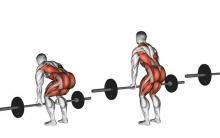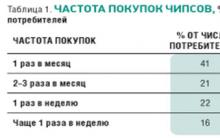Division of a circle by six equal parts and the construction of a regular inscribed hexagon is performed using a square with angles of 30, 60 and 90 º and / or a compass. When dividing the circle into six equal parts with a compass from two ends of the same diameter with a radius equal to the radius of the given circle, arcs are drawn until they intersect with the circle at points 2, 6 and 3, 5 (Fig. 2.24). Consistently connecting the points obtained, a regular inscribed hexagon is obtained.
Figure 2.24
When dividing a circle with a compass from the four ends of two mutually perpendicular diameters of the circle, an arc is drawn with a radius equal to the radius of the given circle, until it intersects with the circle (Fig. 2.25). By connecting the points obtained, a dodecagon is obtained.

Figure 2.25
2.2.5 Division of a circle into five and ten equal parts
and construction of a regular inscribed pentagon and decagon
The division of a circle into five and ten equal parts and the construction of a regular inscribed pentagon and decagon is shown in Fig. 2.26.

Figure 2.26
Half of any diameter (radius) is divided in half (Fig. 2.26 a), point A is obtained. From point A, as from the center, an arc is drawn with a radius equal to the distance from point A to point 1 to the intersection with the second half of this diameter, at point B ( Fig. 2.26 b ). Segment 1 is equal to the chord that subtends the arc, the length of which is equal to 1/5 of the circumference. Making serifs on a circle (Fig. 2.26, in ) radius To, equal to the segment 1B, divide the circle into five equal parts. The starting point 1 is chosen depending on the location of the pentagon. Points 2 and 5 are built from point 1 (Fig. 2.26, c), then point 3 is built from point 2, and point 4 is built from point 5. The distance from point 3 to point 4 is checked with a compass. If the distance between points 3 and 4 is equal to the segment 1B, then the constructions were performed exactly. It is impossible to perform serifs sequentially, in one direction, since errors occur and the last side of the pentagon turns out to be skewed. Consistently connecting the points found, a pentagon is obtained (Fig. 2.26, d).
The division of the circle into ten equal parts is performed similarly to the division of the circle into five equal parts (Fig. 2.26), but first the circle is divided into five parts, starting from point 1, and then from point 6, located at the opposite end of the diameter (Fig. 2.27, a). By connecting all the points in series, they get the correct inscribed decagon (Fig. 2.27, b).

Figure 2.27
2.2.6 Division of a circle into seven and fourteen equal
parts and the construction of a regular inscribed heptagon and
tetradecagon
The division of a circle into seven and fourteen equal parts and the construction of a regular inscribed heptagon and a fourteen-gon is shown in Fig. 2.28 and 2.29.
From any point on the circle, for example point A , an arc is drawn with a radius of a given circle (Fig. 2.28, a ) to the intersection with the circle at points B and D . Connect the points B and D with a straight line. Half of the resulting segment (in this case, segment BC) will be equal to the chord that subtends the arc, which is 1/7 of the circumference. With a radius equal to the segment BC, notches are made on the circle in the sequence shown in Fig. 2.28, b . By connecting all the points in series, they get a regular inscribed heptagon (Fig. 2.28, c).
The division of the circle into fourteen equal parts is performed by dividing the circle into seven equal parts twice from two points (Fig. 2.29, a).

Figure 2.28
First, the circle is divided into seven equal parts from point 1, then the same construction is performed from point 8 . The constructed points are connected in series with straight lines and get a regular inscribed fourteen (Fig. 2.29, b).

Figure 2.29
Building an ellipse
The image of a circle in a rectangular isometric projection in all three projection planes is an ellipse of the same shape.
The direction of the minor axis of the ellipse coincides with the direction of the axonometric axis, perpendicular to the plane of projections in which the depicted circle lies.
When constructing an ellipse representing a circle, large diameter, it is enough to construct eight points belonging to the ellipse (Fig. 2.30). Four of them are the ends of the axes of the ellipse (A, B, C, D), and four others (N 1, N 2, N 3, N 4) are located on straight lines parallel to the axonometric axes, at a distance equal to the radius of the depicted circle from the center ellipse.
Sometimes, for the manufacture of stencils, templates, drawings, patterns, crafts, it is necessary to separate for 6 parts.
For example, we needed to make a template for a flower in the form of a six-pointed star.
For those who have forgotten geometry, I remind you that there are two ways to divide a circle into 6 parts:
- Via protractor.
- Via compass.
1. How to divide a circle into 6 parts using a protractor
Dividing a circle with a protractor is very easy.
We draw a line connecting the center and any point (for example, point 1) on the circle. From this line, using a protractor, we set aside an angle of 60, 120, 180 degrees. We put points on the circle (for example, points 2, 3, 4) We unfold the protractor and divide the other part of the circle in the same way.

2. How to divide a circle into 6 parts using a compass
It happens that there is no protractor at hand. Then the circle can be divided into 6 equal parts using a compass.
We draw a circle, for example, with a radius of 5 cm (red circle). Without changing the radius, we transfer the leg of the compass to the circle (point 1) and draw another circle. We get two points of intersection of the black and red circles 6 and 2.
We move the leg of the compass to point 2 and draw a circle again. We get point 3.
Move the leg of the compass to point 3. Draw a circle again.
Thus, we continue to divide the circle until we divide it into 6 equal parts.

Dividing a circle into equal parts
Division into 3 parts(Fig. 12, a). From the end of the diameter of the circle, an arc is drawn with a radius R equal to the radius of the circle. The arc forms two necessary points on the circle. The third point is at the opposite end of the diameter.
Division into 4 and 8 parts. When dividing the circle into 4 parts, a compass and a ruler will help, with the help of which it is necessary to draw two mutually perpendicular diameters (Fig. 12, b). If we draw one diameter and from one of its ends describe an arc slightly larger than the radius R, and draw another arc of the same radius from the opposite end of the diameter, then by connecting the points of their intersection with a straight line (which will pass through the center), we will obtain a second diameter perpendicular to the first. The intersection points of perpendicular diameters with a circle divide it into 4 equal parts.
To divide the circle into 8 equal parts (Fig. 12, in) it is necessary to construct two pairs of mutually perpendicular diameters.

Rice. 12. Dividing a circle into equal parts: a- into three parts; b- into four parts; in- into eight parts; G- into five parts (1st method); d- into five parts (2nd method); e- into six parts; well- into seven parts.
Division into 5 parts. Dividing a circle into 5 parts can be done in several ways. The first method (Fig. 12, G) involves the use of a compass and ruler. First, in a known way, it is necessary to draw two mutually perpendicular diameters. After that the radius R to be divided in half: extreme point crossing the horizontal diameter, it is necessary to draw an arc of radius R and through two points formed at the intersection of this arc with a circle, draw a straight line - it will divide the horizontal line of radius R in half. From the division point (? R) draw an arc with a radius r(equal to the distance from the point? R to the intersection point of the circle with the vertical diameter). This arc will intersect the second half of the horizontal diameter at the point With. A segment equal to the distance from a point With to the point of intersection of the circle with the vertical diameter, will correspond to the side of the desired pentagon inscribed in the circle. It is necessary to set the compass to a value equal to the length of this segment, and draw an arc of a given radius from the upper intersection point of the circle with a vertical diameter - the point of its intersection with the circle will be the next vertex of the pentagon. From the vertex found, you need to draw another arc of a given radius - this will be the third vertex of the pentagon, from which, in turn, you will need to draw the next arc, and so on until the circle is divided into 5 equal parts. If after that we draw the next five arcs of a given radius, but starting from the lower point of intersection of the circle with the vertical diameter, then the circle will be divided into 10 equal parts. In addition, in fig. 12, G, segment SO on a horizontal diameter corresponding to 1/10 of the circle, that is, if 10 arcs are sequentially drawn on the circle with a radius corresponding to the value of the segment SO, the circle is also divided into 10 equal parts.
In the second method (Fig. 12, d) on the diameter of the circle, using the already known technique, it is necessary to find a point that divides the radius R in half. Draw a straight line from this point until it intersects with the end of the diameter (points With). Then from the point R/2 draw an arc with a radius equal to? R, until it intersects with the drawn line at the point E. Further with a compass from the point With draw an arc with a radius equal to the segment ce, until it intersects the circle at points BUT and AT. Line segment AB- face of a pentagon. Now it remains to draw from the points BUT and AT arcs with a radius equal to the value of the segment AB to sequentially divide the circle into 5 parts.
There is also a way to divide a circle into 5 parts using a protractor. to the radius R circle, you need to attach a protractor, build a central angle of 72 ° (360: 5 \u003d 72) and draw a straight line from the center to the point of its intersection with the circle. The resulting point must be connected to the intersection point of the radius R on a circle - this segment will be the side of the pentagon. By drawing arcs from both points with a radius corresponding to the length of this segment, you can divide the circle into 5 parts.
Division into 6 and 12 parts(Fig. 12, e). From the points of intersection of the circle with the vertical diameter, two arcs are drawn, the radius of which is equal to the radius of the circle. The intersection of arcs on a circle forms points that are successively connected by chords. The result is a hexagon inscribed in a circle. To divide the circle into 12 parts, the same construction is made, but only on two mutually perpendicular diameters.
Division into 7 parts(Fig. 12, well). From the end of any diameter, an auxiliary arc is drawn with a radius R. Through the points of its intersection with the circle, a chord is drawn equal to the side of a correctly inscribed triangle (as in Fig. 12, a). Half of the chord is equal to the side of the heptagon inscribed in the circle. Now it is enough to successively lay a few arcs on the circle with a radius equal to half the chord to divide the circle into 7 parts.
Division into any number of parts(Fig. 13). In this case, the circle is divided into 9 parts.
Two mutually perpendicular straight lines are drawn through the center of the circle. One of the diameters CD, divided by a ruler into the required number of equal parts (in this case 9), the points are numbered. Further from the point D draw an arc with a radius equal to the diameter of the given circle (2 R), until it intersects with a perpendicular line AB. From the points of intersection BUT and AT conduct rays, but in such a way that they pass only through even or only through odd (as in this case) numbers. When crossing with a circle, the rays form points that divide the circle into the desired number of parts (in this case, 9).
Rice. thirteen. Division of a circle into any given number of parts.
From the book Loggias and balconies author Korshever Natalya GavrilovnaAssembling the Triple Part Figure 27 shows the overall design, material cutting, and parts assembly. The frame consists of longitudinal front and rear sides, as well as outer and inner sides. They are glued together and additionally fixed with
From the book Cottage. Construction and finishing author Mayer RonaldAssembling the double section The assembly of the double section of the sofa (Fig. 28) is carried out in the same way as the assembly of the triple section. It remains to be noted that the back wall with the corner table should protrude to the right with a side edge for docking with the first part of the sofa. Of course, if they allow
From the book Wood carving [Techniques, techniques, products] author Podolsky Yuriy FedorovichConstruction of the “light” part of the house: ground floor Construction work is now progressing faster than in the basement, as the blocks external walls the first floor, due to the necessary thermal insulation, is much lighter than the blocks used to build the basement. big
From the book Cosmetics and Soap handmade author Zgurskaya Maria PavlovnaConstruction of a circle of large diameter The construction of a circle of small diameter is carried out using a compass, which does not cause difficulties. At the same time, the possibility of constructing a circle of large diameter is limited by the size of the compass. Help to get out of trouble
From the author's bookDetermining the center of a circle One way to determine the center of a circle is shown in fig. 14, c: any three points (A, B, and C) are chosen on the circle, they are connected by two or three segments and these segments are divided in half using a perpendicular to them. Intersection point
From the author's bookThe result is too soft soap that falls apart when cut. If the soap breaks apart when cut, and at the same time it is also very soft, oily, but you did everything right and according to the right recipe, your soap most likely could not pass the gel phase. For solutions
When performing graphic work, you have to solve many construction tasks. The most common tasks in this case are the division of line segments, angles and circles into equal parts, the construction of various conjugations.
Dividing a circle into equal parts using a compass
Using the radius, it is easy to divide the circle into 3, 5, 6, 7, 8, 12 equal sections.
Division of a circle into four equal parts.
Dash-dotted center lines drawn perpendicular to one another divide the circle into four equal parts. Consistently connecting their ends, we get a regular quadrilateral
(Fig. 1) .Fig.1 Division of a circle into 4 equal parts.
Division of a circle into eight equal parts.
To divide a circle into eight equal parts, arcs equal to the fourth part of the circle are divided in half. To do this, from two points limiting a quarter of the arc, as from the centers of the radii of the circle, notches are made outside it. The resulting points are connected to the center of the circles and at their intersection with the line of the circle, points are obtained that divide the quarter sections in half, i.e., eight equal sections of the circle are obtained (Fig. 2 ).

Fig.2. Division of a circle into 8 equal parts.
Division of a circle into sixteen equal parts.
Dividing an arc equal to 1/8 into two equal parts with a compass, we will put serifs on the circle. Connecting all serifs with straight line segments, we get a regular hexagon.

Fig.3. Division of a circle into 16 equal parts.
Division of a circle into three equal parts.
To divide a circle of radius R into 3 equal parts, from the point of intersection of the center line with the circle (for example, from point A), an additional arc of radius R is described as from the center. Points 2 and 3 are obtained. Points 1, 2, 3 divide the circle into three equal parts.

Rice. 4. Division of a circle into 3 equal parts.
Division of a circle into six equal parts. The side of a regular hexagon inscribed in a circle is equal to the radius of the circle (Fig. 5.).
To divide a circle into six equal parts, it is necessary from points 1 and 4 intersection of the center line with the circle, make two serifs on the circle with a radius R equal to the radius of the circle. Connecting the obtained points with line segments, we get a regular hexagon.

Rice. 5. Dividing the circle into 6 equal parts
Division of a circle into twelve equal parts.
To divide a circle into twelve equal parts, it is necessary to divide the circle into four parts with mutually perpendicular diameters. Taking the points of intersection of the diameters with the circle BUT , AT, With, D beyond the centers, four arcs are drawn by the radius to the intersection with the circle. Received points 1 , 2 , 3 , 4 , 5 , 6 , 7 , 8 and points BUT , AT, With, D divide the circle into twelve equal parts (Fig. 6).

Rice. 6. Dividing the circle into 12 equal parts
Dividing a circle into five equal parts
From a point BUT draw an arc with the same radius as the radius of the circle before it intersects with the circle - we get a point AT. Lowering the perpendicular from this point - we get the point With.From point With- the midpoint of the radius of the circle, as from the center, by an arc of radius CD make a notch on the diameter, get a point E. Line segment DE equal to the length of the side of the inscribed regular pentagon. By making a radius DE serifs on the circle, we get the points of dividing the circle into five equal parts.

Rice. 7. Dividing the circle into 5 equal parts
Dividing a circle into ten equal parts
By dividing the circle into five equal parts, you can easily divide the circle into 10 equal parts. Having drawn straight lines from the resulting points through the center of the circle to the opposite sides of the circle, we get 5 more points.

Rice. 8. Dividing the circle into 10 equal parts
Dividing a circle into seven equal parts
To divide a circle of radius R into 7 equal parts, from the point of intersection of the center line with the circle (for example, from the point BUT) describe how from the center an additional arc the same radius R- get a point AT. Dropping a perpendicular from a point AT- get a point With.Line segment Sun equal to the length of the side of the inscribed regular heptagon.

Rice. 9. Dividing the circle into 7 equal parts
Division of a circle into three equal parts. Install a square with angles of 30 and 60 ° with a large leg parallel to one of the center lines. Along the hypotenuse from a point 1 (first division) draw a chord (Fig. 2.11, a), getting the second division - point 2. Turning the square and drawing the second chord, get the third division - point 3 (Fig. 2.11, b). By connecting points 2 and 3; 3 and 1 straight lines form an equilateral triangle.
Rice. 2.11.
a, b - c using a square; in- using a circle
The same problem can be solved using a compass. By placing the support leg of the compass at the lower or upper end of the diameter (Fig. 2.11, in) describe an arc whose radius is equal to the radius of the circle. Get the first and second divisions. The third division is at the opposite end of the diameter.
Dividing a circle into six equal parts
The compass opening is set equal to the radius R circles. From the ends of one of the diameters of the circle (from the points 1, 4 ) describe arcs (Fig. 2.12, a, b). points 1, 2, 3, 4, 5, 6 divide the circle into six equal parts. By connecting them with straight lines, they get a regular hexagon (Fig. 2.12, b).

Rice. 2.12.
The same task can be performed using a ruler and a square with angles of 30 and 60 ° (Fig. 2.13). The hypotenuse of the square must pass through the center of the circle.

Rice. 2.13.
Dividing a circle into eight equal parts
points 1, 3, 5, 7 lie at the intersection of the center lines with the circle (Fig. 2.14). Four more points are found using a square with angles of 45 °. When receiving points 2, 4, 6, 8 the hypotenuse of a square passes through the center of the circle.

Rice. 2.14.
Dividing a circle into any number of equal parts
To divide a circle into any number of equal parts, use the coefficients given in Table. 2.1.
Length l chord, which is laid on a given circle, is determined by the formula l = dk, where l- chord length; d is the diameter of the given circle; k- coefficient determined from Table. 1.2.
Table 2.1
Coefficients for dividing circles
To divide a circle of a given diameter of 90 mm, for example, into 14 parts, proceed as follows.
In the first column of Table. 2.1 find the number of divisions P, those. 14. From the second column write out the coefficient k, corresponding to the number of divisions P. In this case, it is equal to 0.22252. The diameter of a given circle is multiplied by a factor and the length of the chord is obtained l=dk= 90 0.22252 = 0.22 mm. The resulting length of the chord is set aside with a measuring compass 14 times on a given circle.
Finding the center of the arc and determining the size of the radius
An arc of a circle is given, the center and radius of which are unknown.
To determine them, you need to draw two non-parallel chords (Fig. 2.15, a) and set up perpendiculars to the midpoints of the chords (Fig. 2.15, b). Centre O arc is at the intersection of these perpendiculars.

Rice. 2.15.
Pairings
When performing machine-building drawings, as well as when marking workpieces in production, it is often necessary to smoothly connect straight lines with arcs of circles or an arc of a circle with arcs of other circles, i.e. perform pairing.
Pairing called a smooth transition of a straight line into an arc of a circle or one arc into another.
To build mates, you need to know the value of the radius of the mates, find the centers from which the arcs are drawn, i.e. interface centers(Fig. 2.16). Then you need to find the points at which one line passes into another, i.e. connection points. When constructing a drawing, mating lines must be brought exactly to these points. The point of conjugation of the arc of a circle and a straight line lies on a perpendicular lowered from the center of the arc to the mating line (Fig. 2.17, a), or on a line connecting the centers of mating arcs (Fig. 2.17, b). Therefore, to construct any conjugation by an arc of a given radius, you need to find interface center and point (points) conjugation.

Rice. 2.16.

Rice. 2.17.
The conjugation of two intersecting lines by an arc of a given radius. Given straight lines intersecting at right, acute and obtuse angles (Fig. 2.18, a). It is necessary to construct conjugations of these lines by an arc of a given radius R.

Rice. 2.18.
For all three cases, the following construction can be applied.
1. Find a point O- the center of the mate, which must lie at a distance R from the sides of the corner, i.e. at the point of intersection of lines passing parallel to the sides of the angle at a distance R from them (Fig. 2.18, b).
To draw straight lines parallel to the sides of an angle, from arbitrary points taken on straight lines, with a compass solution equal to R, make serifs and draw tangents to them (Fig. 2.18, b).
- 2. Find the junction points (Fig. 2.18, c). For this, from the point O drop perpendiculars to given lines.
- 3. From point O, as from the center, describe an arc of a given radius R between junction points (Fig. 2.18, c).











Mars space program
The history of the origin of zero What is the name of zero
Gloria planet (anti-earth) - exposing all revelations Is it true that there is a planet behind the sun
20 cases of alleged reincarnation
The secret of the "sun stones": how the Vikings got from Norway to Greenland almost blindly